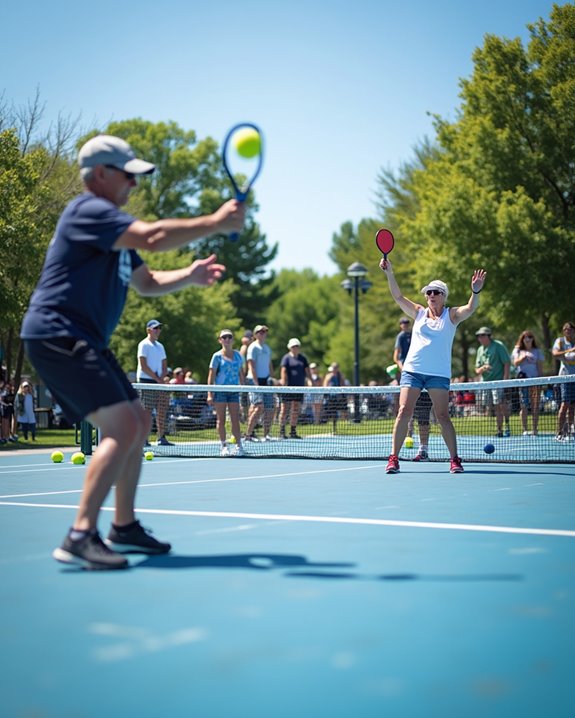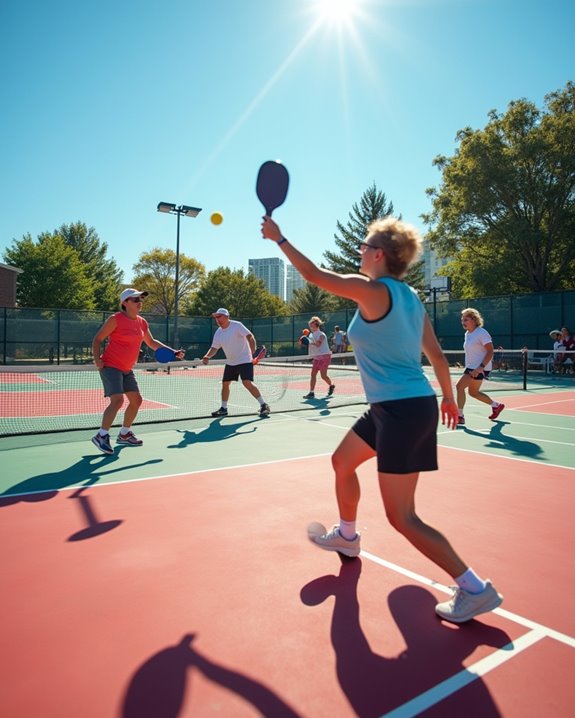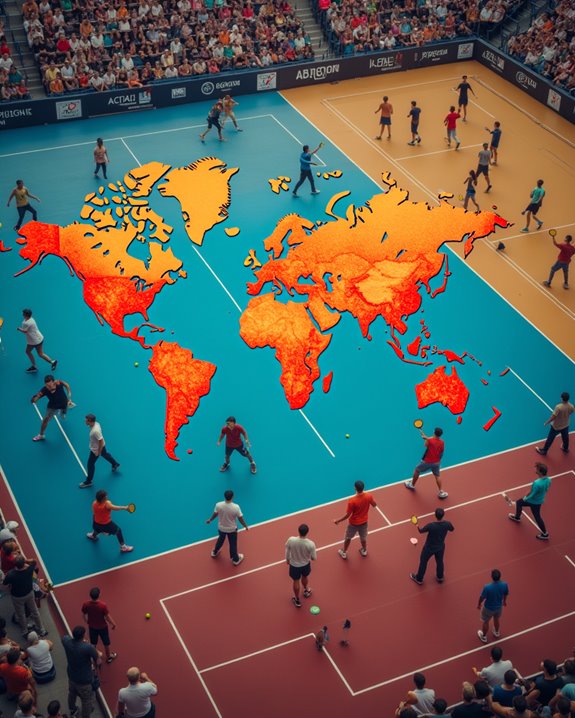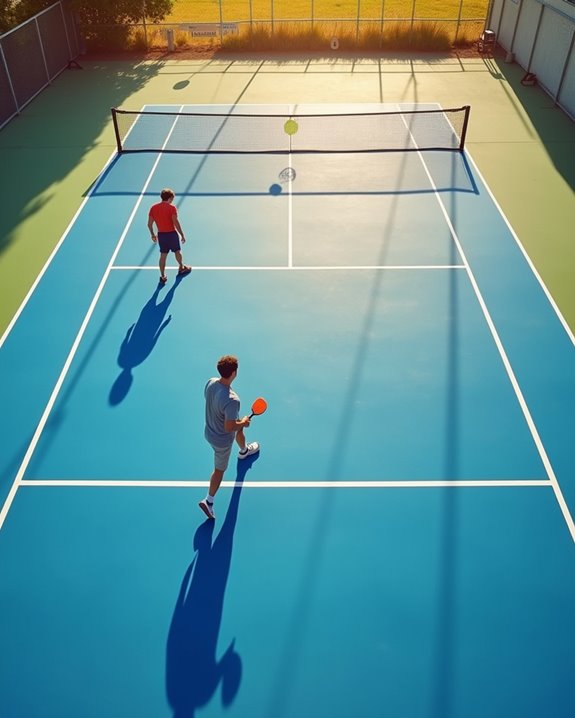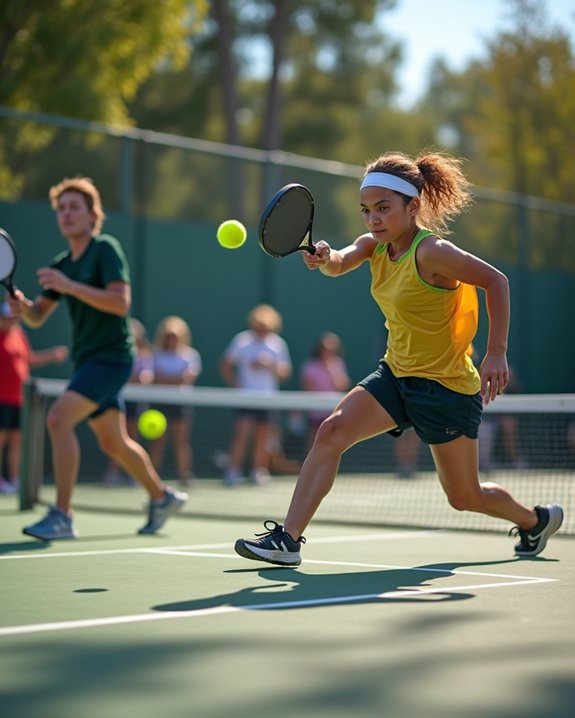Pickleball’s popularity simmered in three distinct waves. You’ll find it first gained traction in retirement communities during the early 2000s, where its paddle-slapping action offered accessible recreation. Around 2010-2016, mainstream media coverage and professional tournaments folded the sport into public awareness. Then came the pandemic boom—participation nearly tripled from 3.5 million players in 2019 to 8.9 million by 2022! Discover how this once-niche activity transformed from backyard pastime to America’s hottest sporting sensation.
Key Takeaways
- Although created in 1965, pickleball began gaining popularity in the 1980s with the formation of the U.S.A.P.A. in 1984.
- By 1990, the sport had spread to all 50 states, showing early signs of mainstream adoption.
- A significant popularity surge occurred in retirement communities between 2000-2010, establishing the sport’s core audience.
- Media exposure in 2008 on Good Morning America helped introduce pickleball to a wider national audience.
- The COVID-19 pandemic triggered unprecedented growth, with player numbers jumping from 3.5 million in 2019 to 8.9 million by 2022.
The 1965 Birth of Pickleball on Bainbridge Island
Three friends on a summer day in 1965 whipped up a recipe for what would become America’s fastest-growing sport. Joel Pritchard, Bill Bell, and Barney McCallum weren’t master chefs, but they expertly blended ingredients for a backyard game on Bainbridge Island, Washington. They folded in a badminton court, whisked the net lower, and stirred in plywood paddles.
The name pickleball? Joan Pritchard seasoned the mix, inspired by “pickle boats” in crew racing (though some say their dog Pickles contributed the moniker). By 1967, the first permanent court simmered at Bob O’Brian’s property.
You’ll appreciate how the sport’s design prioritized accessibility—a perfect blend of ping-pong’s precision and tennis’s dynamic movement that players of all ages could savor.
Early Growth and Organization (1970s-1990s)
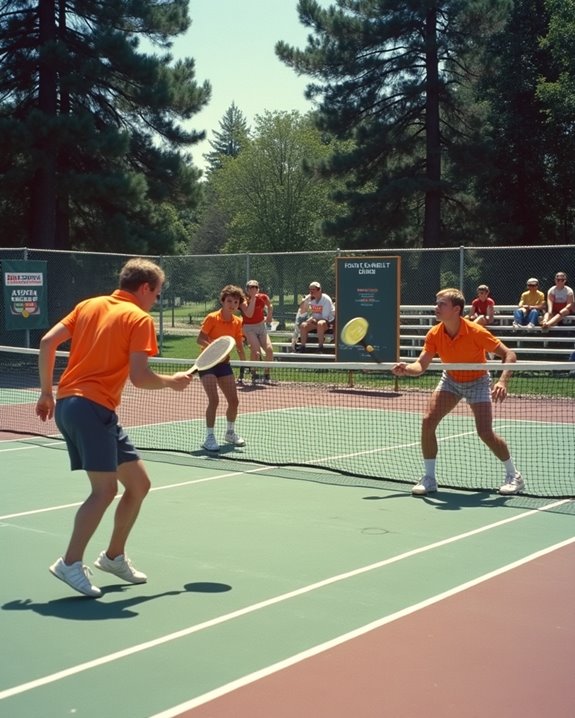
From pickleball’s humble backyard beginnings, the sport began to simmer across America throughout the 1970s. When the name “Pickle-ball” was trademarked in 1972, the first company dedicated to the sport began to spread this addictive recipe for fun across the country.
You might be surprised to learn that formal recognition came in 1976 with the first pickleball tournament at South Center Athletic Club in Tukwila, Washington. By 1984, the U.S.A.P.A. formed as the governing body, whipping up the first official rulebook—an essential ingredient for any growing sport.
As dedicated courts and organized tournaments folded into communities nationwide, a flavorful blend of players created a community around the sport. By 1990, pickleball had been served in all 50 states, proving its growing popularity wasn’t just a flash in the pan.
The Retirement Community Boom (2000-2010)
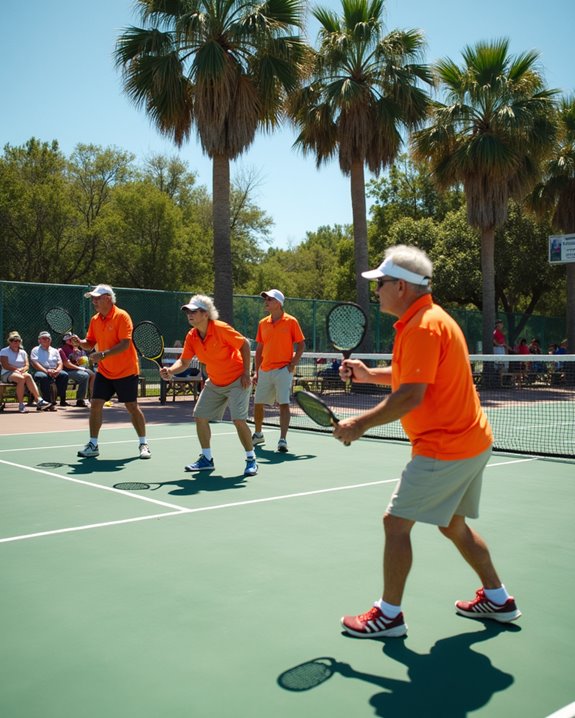
As the new millennium dawned, pickleball began simmering in an unexpected venue that would ultimately spice up the sport’s popularity across America—retirement communities. The sport’s low-impact nature made it the perfect recipe for older adults hungry for both physical and social activities.
By 2010, you’d find dedicated pickleball courts being served up in retirement communities nationwide, with facilities folding this ingredient into their recreational offerings. The sport marinaded in community engagement, as residents whisked together tournaments and leagues that brought a dash of friendly competition to the courts.
This retirement community boom created the perfect blend for pickleball’s overall growth, as enthusiastic players spread the flavor to friends and family outside these communities, helping the sport rise to new heights.
Mainstream Recognition and Media Coverage
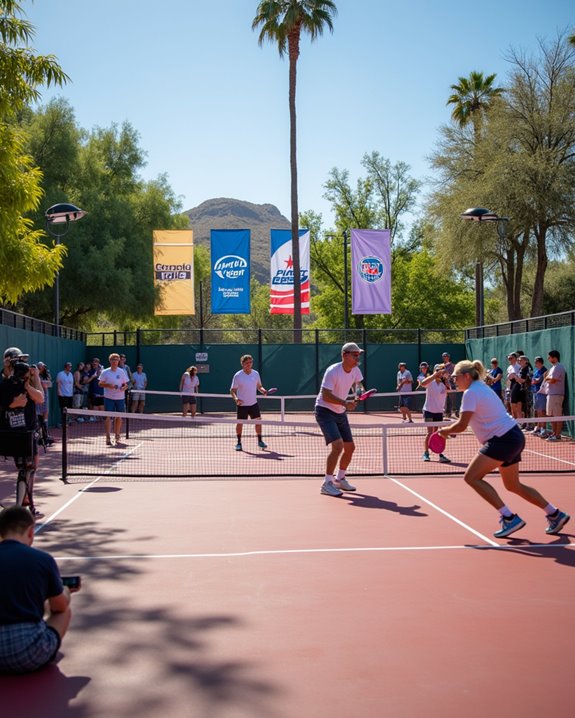
While simmering in retirement communities throughout the early 2000s, pickleball finally boiled over into mainstream consciousness when Good Morning America served up a feature segment in 2008, introducing millions of viewers to the paddle-wielding phenomenon.
You couldn’t ignore pickleball’s popularity as it was consistently labeled the fastest growing sport by the Sports and Fitness Industry Association. The sport’s recipe for success included key ingredients: the inaugural US Open Pickleball Championships in 2016, the establishment of the International Federation of Pickleball, and USA Pickleball’s national referee certification program.
The dish was perfected when the Margaritaville USA Pickleball National Championships attracted nearly 28,000 fans in 2019. By 2024, you’ll be joining an estimated 19.8 million participants who’ve developed a taste for this addictive court sport.
The Pandemic Effect on Pickleball’s Explosion

When COVID-19 lockdowns forced Americans indoors in early 2020, pickleball simmered to a rapid boil as the perfect pandemic-friendly activity. You could practically taste the sport’s appeal as participation numbers more than doubled from 3.5 million players in 2019 to a hearty 8.9 million by 2022.
While gyms were off the menu, pickleball served up the perfect recipe for community engagement while maintaining social distance. Older adults especially savored this low-impact exercise option, flocking to nearly 21,000 courts nationwide as new courts were continuously added to the mix.
Social media visibility whisked the sport into mainstream consciousness, with videos showcasing pickleball’s accessibility folded into feeds everywhere. The pandemic fundamentally pressure-cooked what might have been years of gradual growth into an overnight sensation.
Professional Tours and Competitive Evolution

From pickleball’s humble backyard beginnings to today’s stadium-sized spectacles, the sport has been simmering toward professional legitimacy since the first formal tournament bubbled up in 1976.
You’re witnessing the rapid boil of pickleball’s competitive evolution through professional tours that have thoroughly transformed the landscape. The Professional Pickleball Association has turned up the heat with a sizzling $5.5 million purse in 2023, while Major League Pickleball has folded in high-profile owners like LeBron James and Tom Brady to create a rich competitive broth. The establishment of the Association of Pickleball Players and U.S. Collegiate Championships has added more ingredients to this growing feast, elevating both the visibility and financial stakes of the sport. These professional platforms have perfectly seasoned pickleball’s journey from recreational activity to mainstream phenomenon.
Celebrity Endorsements and Investment Impact

The star-studded flavor profile of pickleball has transformed this once-humble dish into a gourmet sensation. You’ve likely noticed high-profile endorsements from Tom Brady, LeBron James, and Ellen DeGeneres simmering in the media, perfectly seasoning the sport for mass consumption.
When Major League Pickleball launched in 2021, celebrity investors poured in, whipping up team expansion fees exceeding $3 million. This investment has folded commercial interest and substantial prize money—like the PPA’s $5.5 million purse in 2023—into the pickleball batter.
The visibility boost through social media has catered to younger players, creating a perfect blend of community engagement. As celebrities continue to garnish pickleball with their influence, you’re witnessing the sport’s popularity rise like a perfectly proofed dough, ready for even greater consumption.
Global Expansion and Olympic Aspirations

While America’s paddle-wielding enthusiasts have dominated the pickleball scene, the sport’s flavor profile is now tantalizing taste buds across continents with remarkable speed. You’re witnessing the perfect recipe for global expansion, with nearly 9 million U.S. players in 2023 and international participation simmering nicely.
The International Federation of Pickleball is whisking together Olympic recognition efforts, folding this once-niche activity into the mainstream sports landscape. With 11,000 courts mapped worldwide, infrastructure development has created a hearty base for growth.
Major tournaments like the Margaritaville USA Pickleball National Championships are serving as the garnish that attracts new players. Meanwhile, the sport is being plated for younger audiences, with NCAA adoption predicted soon—further proof that pickleball’s popularity continues to rise like perfectly proofed dough.
Frequently Asked Questions
When Did Pickleball Start Trending?
You’ve likely noticed pickleball’s 311% growth since 2021! This recreational activity started trending in the early 2000s, with social media influence and community engagement propelling it from niche game to mainstream athletic trend by 2020.
Who Started the Pickleball Craze?
You’ve seen pickleball history unfold through grassroots movements and fitness trends. The USAPA legitimized it in 2005, while celebrity endorsements and social media accelerated its popularity, transforming community events and local tournaments nationwide.
When Did People Start Playing Pickleball?
Pickleball history dates back to 1965 when it started as a backyard game. You’d find early adopters playing with original rules in family activities. By 1976, the first tournament formalized this community involvement, sparking local leagues.
How Did Pickleball Go Viral?
Like wildfire through dry brush, pickleball’s viral explosion came from a perfect storm of celebrity endorsements, social media influence, grassroots movement impact, and media coverage increase. You’ve witnessed the pickleball community growth firsthand!

